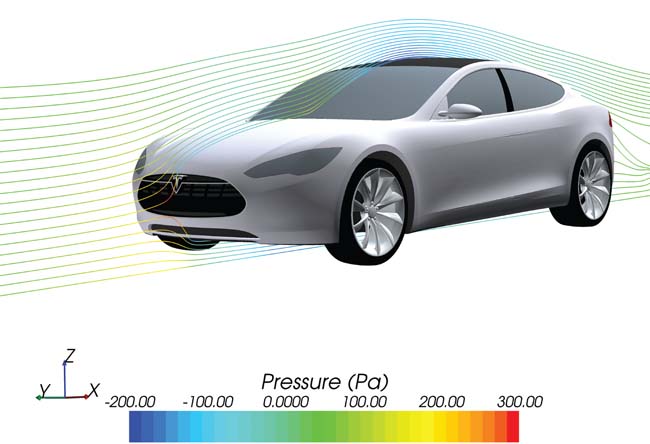STAR-CCM+ Solves Aerodynamics and Heat in Tesla Model S
CFD simulation of an all-electric sedan enables engineers to see where aerodynamic drag and thermal energy needs to be reduced.
Latest News
January 3, 2010
By Vince Johnston
At Tesla Motors we run lean and go fast. This is true of our vehicles and of our engineering and analysis teams, who have developed today’s all-electric Roadster, the only highway-capable electric vehicle currently in production, with a 240+ mile range and a 0-60 mph time of 3.9 seconds.
 STAR-CCM+ computational fluid dynamics software from CD-adapco helped Tesla engineers address a broad range of electric vehicle engineering challenges quickly and accurately. |
When Tesla decided to bring the aerodynamics development and thermal engineering of its new Model S sedan in house, it chose the STAR-CCM+ computational fluid dynamics software from CD-adapco to help address a broad range of electric vehicle engineering challenges quickly and accurately.
Borrowing from Yesterday for Tomorrow While Tesla Motors is carrying the inventor’s name forward in the advancement of electrical science, it is hoping to reduce its impact on the environment. That is why the tires and the battery of every Tesla Motors vehicle are recyclable. Reuse is such a key part of Tesla Motors’ philosophy that it arranged to have its car batteries safely recycled before the first Tesla car was sold. The cost of recycling is built into the purchase price of the car, so there is never reason not to recycle. |
STAR-CCM+ is deployed among several groups at Tesla Motors including Aerodynamics, HVAC Systems, and Powertrain Engineering. A key to its successful deployment is the ability to go from a CAD model to a CFD solution within one tool, allowing expertise in CAD correction, computational mesh generation, and physics modeling to develop within a single platform across a broad range of users. Within STAR-CCM+, it’s a straightforward process to add, remove, or modify geometry and physics models, allowing engineers to quickly see the results of modifications on quantities like drag, lift, pressure loss, temperature, and mass flow.
Our goal in this project was to achieve exceptional range without compromising the performance of the Model S. To do that, we analyzed every aspect of the vehicle to conserve energy.
In the simplest terms, range is the net result of the on-board energy carrying capacity of the vehicle and the efficiency in applying that energy to accelerate and propel the vehicle’s mass—minus all the opposing forces. These include rolling resistance, gravity on grade, and aerodynamic drag. At highway speeds, aerodynamic forces dominate the opposing forces, so it’s easy to see that to achieve increases in range the most effective means are to reduce the aerodynamic drag of the vehicle and add more on-board energy capacity. But increasing battery-energy capacity typically increases the cost, weight, and battery size, and is also likely to increase the amount of thermal energy that has to be removed from the vehicle. Heat transfer devices such as radiators and condensers work well in removing heat, but often at the cost of aerodynamic performance and further energy losses through the use of electric fans coupled to the heat exchangers.
CD-adapco’s STAR-CCM+ software provided Tesla Motors with a tool to simulate and evaluate all of the aerothermal components and interactions to optimize range performance and minimize vehicle energy consumption. As a result, the Model S Sedan (which is due to hit the streets in 2011) has a range of up to 300 miles. Compared to competitors whose typical electrically powered range ventures up to 60 miles, this represents a huge advantage. Its batteries can be charged from any electrical outlet and only takes about 3.5 hours to reach a full recharge. Additional features like regenerative braking, which recovers and stores the energy usually lost when the car slows, extends the charge even further, delivering higher miles-per-charge on in-town driving. All of these features enable Tesla Motors’ cars to run as cheaply as 1 cent per mile.
All of this is delivered without compromise to performance. The S sedan’s peak torque starts at 0 rpm and stays powerful at 14,000 rpm. This is the opposite of the performance of gasoline engines, which have very little torque at low rpm and only reach peak torque in a narrow range of rpm. The nearly constant torque of Tesla Motors’ cars results in great acceleration with high energy efficiency at the same time.
More Info:
CD-adapco
Vince Johnston is the engineering manager at Tesla Motors. To comment, send e-mail to [email protected].
Subscribe to our FREE magazine, FREE email newsletters or both!
Latest News
About the Author
DE’s editors contribute news and new product announcements to Digital Engineering.
Press releases may be sent to them via [email protected].






